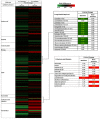Differential effects of dietary supplements on metabolomic profile of smokers versus non-smokers
- PMID: 22360970
- PMCID: PMC3392760
- DOI: 10.1186/gm313
Differential effects of dietary supplements on metabolomic profile of smokers versus non-smokers
Abstract
Background: Cigarette smoking is well-known to associate with accelerated skin aging as well as cardiovascular disease and lung cancer, in large part due to oxidative stress. Because metabolites are downstream of genetic variation, as well as transcriptional changes and post-translational modifications of proteins, they are the most proximal reporters of disease states or reversal of disease states.
Methods: In this study, we explore the potential effects of commonly available oral supplements (containing antioxidants, vitamins and omega-3 fatty acids) on the metabolomes of smokers (n = 11) compared to non-smokers (n = 17). At baseline and after 12 weeks of supplementation, metabolomic analysis was performed on serum by liquid and gas chromatography with mass spectroscopy (LC-MS and GC-MS). Furthermore, clinical parameters of skin aging, including cutometry as assessed by three dermatologist raters blinded to subjects' age and smoking status, were measured.
Results: Long-chain fatty acids, including palmitate and oleate, decreased in smokers by 0.76-fold (P = 0.0045) and 0.72-fold (P = 0.0112), respectively. These changes were not observed in non-smokers. Furthermore, age and smoking status showed increased glow (P = 0.004) and a decrease in fine wrinkling (P = 0.038). Cutometry showed an increase in skin elasticity in smokers (P = 0.049) but not in non-smokers. Complexion analysis software (VISIA) revealed decreases in the number of ultraviolet spots (P = 0.031), and cutometry showed increased elasticity (P = 0.05) in smokers but not non-smokers.
Conclusions: Additional future work may shed light on the specific mechanisms by which long-chain fatty acids can lead to increased glow, improved elasticity measures and decreased fine wrinkling in smokers' skin. Our study provides a novel, medicine-focused application of available metabolomic technology to identify changes in sera of human subjects with oxidative stress, and suggests that oral supplementation (in particular, commonly available antioxidants, vitamins and omega-3 fatty acids) affects these individuals in a way that is unique (compared to non-smokers) on a broad level.
Figures




Similar articles
-
Effects of omega-3 fatty acid supplementation on cigarette craving and oxidative stress index in heavy-smoker males: A double-blind, randomized, placebo-controlled clinical trial.J Psychopharmacol. 2018 Sep;32(9):995-1002. doi: 10.1177/0269881118788806. Epub 2018 Aug 23. J Psychopharmacol. 2018. PMID: 30136619 Clinical Trial.
-
The effect of omega-3 supplementation on pregnancy outcomes by smoking status.Am J Obstet Gynecol. 2017 Oct;217(4):476.e1-476.e6. doi: 10.1016/j.ajog.2017.05.033. Epub 2017 May 23. Am J Obstet Gynecol. 2017. PMID: 28549983 Free PMC article. Clinical Trial.
-
Effect of ω-3 fatty acid supplementation on endothelial function, endogenous fibrinolysis and platelet activation in male cigarette smokers.Heart. 2013 Feb;99(3):168-74. doi: 10.1136/heartjnl-2012-302924. Epub 2012 Nov 26. Heart. 2013. PMID: 23184014 Clinical Trial.
-
Diet and obstructive lung diseases.Epidemiol Rev. 2001;23(2):268-87. doi: 10.1093/oxfordjournals.epirev.a000806. Epidemiol Rev. 2001. PMID: 12192737 Review.
-
Functional food science and defence against reactive oxidative species.Br J Nutr. 1998 Aug;80 Suppl 1:S77-112. doi: 10.1079/bjn19980106. Br J Nutr. 1998. PMID: 9849355 Review.
Cited by
-
Integration of datasets from different analytical techniques to assess the impact of nutrition on human metabolome.Front Cell Infect Microbiol. 2012 Dec 11;2:156. doi: 10.3389/fcimb.2012.00156. eCollection 2012. Front Cell Infect Microbiol. 2012. PMID: 23248777 Free PMC article. Review.
-
Pathway Analysis of Global Metabolomic Profiles Identified Enrichment of Caffeine, Energy, and Arginine Metabolism in Smokers but Not Moist Snuff Consumers.Bioinform Biol Insights. 2019 Oct 17;13:1177932219882961. doi: 10.1177/1177932219882961. eCollection 2019. Bioinform Biol Insights. 2019. PMID: 31666793 Free PMC article.
-
Effect of smoking reduction and cessation on the plasma levels of the oxidative stress biomarker glutathione--Post-hoc analysis of data from a smoking cessation trial.Free Radic Biol Med. 2016 Feb;91:172-7. doi: 10.1016/j.freeradbiomed.2015.12.018. Epub 2015 Dec 18. Free Radic Biol Med. 2016. PMID: 26708755 Free PMC article.
-
The relationship between omega-3 and smoking habit: a cross-sectional study.Lipids Health Dis. 2016 Mar 22;15:61. doi: 10.1186/s12944-016-0220-9. Lipids Health Dis. 2016. PMID: 27004534 Free PMC article.
-
Exploiting meta-analysis of genome-wide interaction with serum 25-hydroxyvitamin D to identify novel genetic loci associated with pulmonary function.Am J Clin Nutr. 2024 May;119(5):1227-1237. doi: 10.1016/j.ajcnut.2024.03.007. Epub 2024 Mar 12. Am J Clin Nutr. 2024. PMID: 38484975 Free PMC article.
References
-
- Penn A, Snyder C. Inhalation of sidestream cigarette smoke accelerates development of arteriosclerotic plaques. Circulation. 1993;88:1820–1825. - PubMed
LinkOut - more resources
Full Text Sources
Medical
Miscellaneous

